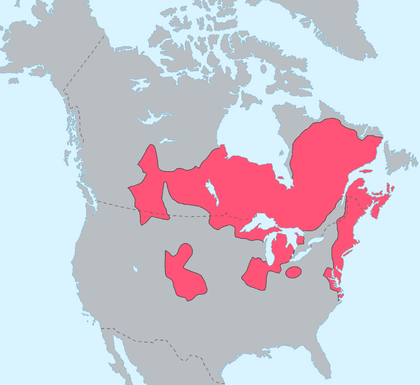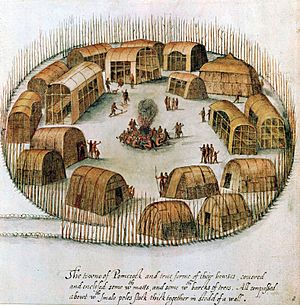Algonquian peoples facts for kids
The Algonquian peoples are a large group of Native American communities. They are known for speaking Algonquian languages. Thousands of people today identify as Algonquian. Historically, these groups lived along the Atlantic Coast. They also lived inland near the Saint Lawrence River and around the Great Lakes.
Before Europeans arrived, most Algonquian groups hunted and fished. Many also grew crops like corn, beans, and squash. These three crops are often called the "Three Sisters". The Ojibwe people also grew wild rice.
The Algonquians in New England had a seasonal way of life. Their main social group was the village, usually a few hundred people. These people were often related through a clan system. Villages were not permanent. People moved to find the best food sources. They might split into smaller groups or gather together as needed. This movement helped them survive, especially during difficult times.
In warm weather, they built portable wigwams. These were huts often with buckskin doors. In winter, they built stronger longhouses. More than one clan could live in a longhouse. They stored food in underground storage areas.
In spring, when fish laid their eggs, they left winter camps. They built villages near the coast or waterfalls. In March, they caught smelt using nets and weirs. They traveled in birch bark canoes. In April, they caught alewife, sturgeon, and salmon. In May, they fished for cod in the ocean. They also caught trout, smelt, striped bass, and flounder in rivers and streams. They even hunted whales, porpoises, walruses, and seals at sea. Women and children gathered scallops, mussels, clams, and crabs.
From April to October, people hunted migratory birds and collected their eggs. These included Canada geese, brant, and mourning doves. In July and August, they gathered strawberries, raspberries, blueberries, and nuts. In September, they divided into small groups. They moved up streams into the forest. There, they hunted beaver, caribou, moose, and white-tailed deer.
In December, when snow fell, people made larger winter camps. They chose sheltered spots and built or rebuilt longhouses. February and March were tough months. Tribes in southern New England and other northern areas relied on stored food. Northern groups sometimes went hungry for days. This practice may have kept their population numbers stable.
The southern Algonquians in New England mostly used slash and burn farming. They cleared fields by burning plants. They farmed these fields for one or two years. Then, the village moved to a new spot. This is why the English found the land somewhat clear for planting. By growing different kinds of corn, beans, and squash, southern groups improved their diets. Their population grew much larger than in the north.
Experts believe that by the year 1600, about 70,000 to 100,000 Native Americans lived in New England.
Contents
Colonial Period: European Arrival
When Europeans first settled in North America, Algonquian peoples lived in many areas. These included what is now New Brunswick, much of Canada east of the Rocky Mountains, and New England. They also lived in New Jersey, southeastern New York, Delaware, and down the Atlantic Coast. Around the Great Lakes, they lived in parts of Minnesota, Wisconsin, Michigan, Illinois, Indiana, and Iowa. The exact original homeland of the Algonquian peoples is not known. When Europeans arrived, the powerful Iroquois Confederacy often fought with their Algonquian neighbors. The Iroquois were based in what is now New York and Pennsylvania.
Algonquian Tribal Groups
Canada
The French and later the English met several Algonquian groups in Canada. These included the Maliseet in present-day Maine, Quebec, and New Brunswick. The Abenaki lived in Quebec, Vermont, and New Hampshire. The Mi'kmaw groups in the Maritimes mainly fished. Further north were the Betsiamite, Atikamekw, Anishinaabe, and Innu/Naskapi. The Beothuk of Newfoundland might have been Algonquians. However, their language and culture are mostly lost as the last known speaker died in the early 1800s.
New England Area
Colonists in the Massachusetts Bay area first met the Wampanoag, Massachusett, Nipmuck, Pennacook, Penobscot, Passamaquoddy, and Quinnipiac peoples. The Mohegan, Pequot, Pocumtuc, Tunxis, and Narragansett lived in southern New England. The Abenaki were in northern New England. This area is now Maine, New Hampshire, and Vermont in the U.S., and eastern Quebec in Canada. They traded with French colonists along the Atlantic coast and the Saint Lawrence River. The Mahican lived in western New England and the upper Hudson River Valley. These groups farmed, hunted, and fished.
Midwest
The French met Algonquian peoples in the Midwest through trade. They had limited settlements in New France along the Mississippi and Ohio rivers. The historic peoples of the Illinois Country included the Shawnee, Illiniwek, Kickapoo, Menominee, Miami, Sauk, and Meskwaki. The Sauk and Meskwaki were also known as the Sac and Fox. They lived across the present-day Midwest of the United States.
In the 1800s, many Native Americans east of the Mississippi River were forced to move. The United States passed laws like Indian removal that pushed people west. They were sent to an area called Indian Territory. This area later became the state of Oklahoma in the early 1900s.
Upper West
The Ojibwe/Chippewa, Odawa, Potawatomi, and various Cree groups lived in the Upper Peninsula of Michigan, Western Ontario, Wisconsin, Minnesota, and the Canadian Prairies. The Arapaho, Blackfoot, and Cheyenne developed as native groups of the Great Plains.
List of Historic Algonquian Speaking Peoples
- Gros Ventre
- Blackfoot Confederacy
- Kispoko
- Cree
- Croatan
- Meskwaki
- Menominee
- Illinois Confederation
- Lenape
- Mahican
- Maliseet
- Mascouten
- Miami people
- Mi'kmaq
- Missiquoi
- Nanticoke people
- Odawa
- Ojibwe
- Passamaquoddy
- Pennacook
- Penobscot
- Pequot
- Potawatomi
- Powhatan
- Roanoke people
- Sauk people
- Cheyenne
- Hathawekela
- Wampanoag
See also
 In Spanish: Pueblos algonquinos para niños
In Spanish: Pueblos algonquinos para niños



